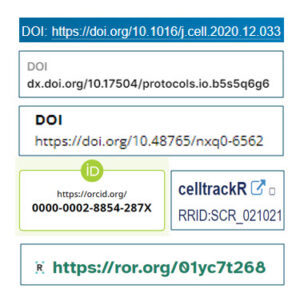Persistent Unique Identifiers (PIDs), also known as Digital Persistent Identifiers (DPIs), are globally unique, persistent, machine-resolvable digital identifiers with an associated metadata schema. A PID identifies and locates an entity regardless of where it is hosted or published and enables its unambiguous and long-term identification. PIDs are an essential component of the research ecosystem, linking researchers and research outputs to their underlying data and associated metadata. In this blog post, we will explore the different types of PIDs, their applications, and how researchers can use PIDs to comply with the FAIR data principles and the funder requirements.

Types of PIDs
There are several types of PIDs commonly used in research, shown as follows.
- PIDs for People (Researchers): Open Researcher and Contributor Identifiers (ORCID iDs)
- PIDs for Objects (Research Outputs): Digital Object Identifiers (DOIs) and Research Resource Identifiers (RRIDs)
- PIDs for Places (Research Organizations): Research Organization Registry (ROR) IDs, and Crossref Funder Registry IDs
ORCID iDs are assigned to researchers and support automatic links to their research outputs. ORCID iDs can be linked to a researcher’s affiliations, funding sources, and publications, making it easier to identify their contributions and track their research impact.
DOIs are the most widely used PIDs assigned to research outputs such as journal articles, protocols, books, datasets, and software. DOIs enable researchers to uniquely identify and cite digital objects, facilitating their discoverability, accessibility, and interoperability.
RRIDs are unique identifiers assigned to research resources such as antibodies, cell lines, model organisms, and other tools (software, databases, services). RRIDs enable researchers to unambiguously identify and cite the research resources they use, facilitating reproducibility and reuse of research data.
ROR IDs are unique identifiers assigned to research organizations, including universities, research institutes, and funding agencies. ROR IDs enable researchers to link their research outputs to their affiliated organizations, making tracking research impact and identifying collaborations easier.
Crossref Funder Registry IDs are unique identifiers assigned to funding agencies, allowing researchers to track the funding sources of their research outputs and demonstrate the impact of specific funding programs.
Applications of PIDs to Comply with FAIR Data Principles
PIDs are not only critical to the implementation of the FAIR (Findable, Accessible, Interoperable, and Reusable) data principles but also to making data machine-readable or machine-actionable. By incorporating PIDs such as DOIs, ORCID iDs, RRIDs, ROR IDs, and Funder IDs in research outputs, researchers can make data more easily discoverable, accessible, interoperable, reusable, and machine-actionable. Machine-actionable data means that data can be processed and understood by machines or software.
PIDs enable researchers to link their research outputs to their underlying data and associated metadata, making it easier to discover and access research data. PIDs also facilitate the reuse of research data or protocols by enabling researchers to easily cite and credit the sources of their data and protocols.
PIDs also play a critical role in ensuring the reproducibility and transparency of research data. PIDs enable researchers to uniquely identify and cite their research resources, facilitating the replication of experiments and ensuring the accuracy of research data.
By incorporating PIDs in their research outputs, researchers can make their data more interoperable, allowing machines to process data and metadata more efficiently. PIDs follow established standards and enable data to be shared and reused without the need for transformations, making data more interoperable with existing and future systems. This facilitates the integration of data from multiple sources and enables researchers to make new discoveries that would not be possible without PIDs.
In conclusion, PIDs play a critical role in research by enabling the unique identification, citation, and linking of research outputs to their underlying data and associated metadata. By incorporating PIDs such as DOIs, ORCID iDs, RRIDs, ROR IDs, and Funder Registry IDs in their research outputs, researchers can make their research outputs more Findable, Accessible, Interoperable, and Reusable (FAIR data principles) required by many funders and publishers and contribute to the open data ecosystem.
Resources
- Four-part blog series of FAIR Data Principles (Findable, Accessible, Interoperable, Reusable)
- PID Services by the Department of Energy’s Office of Scientific and Technical Information (PIDs @DOE OSTI)
- The FAIR Guiding Principles for scientific data management and stewardship | Scientific Data (nature.com)
- FAIR | GO FAIR Foundation
- Research Resource Identifiers (RRIDs)
- Open Researcher and Contributor IDs (ORCID iDs)
- ORCID Overview – ORCID – BeckerGuides at Becker Medical Library (wustl.edu)
- DataCite DOI Service
- Research Organization Registry (ROR)
- Crossref Funder Registry
